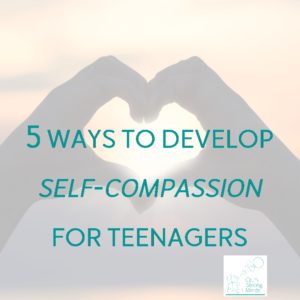Self-compassion for teens
It can be easy to fall into the trap of being hard on ourselves, where being ‘good enough’ just doesn’t seem ‘enough’. However, during the teenage years this is an even easier pattern of thought to fall into and can lead to psychological distress. Developing Self-Compassion is one way to help to reduce the impact of these thoughts had help build long-term resilience.

Statements such as ‘I should do…’, ‘I should be…’, I’m not good enough’, and ‘but they are prettier/cleverer/more organised/funnier’ can be scattered throughout conversations I have with teenagers and young adults. These thought patterns often trigger feelings of anxiety and low mood which can be very difficult cycles to escape from.
There are some good reasons why teenagers are particularly susceptible to self-criticism and self-doubt. There implicit and explicit pressures all around them from society, social media, advertising, peers, schools etc. In addition to that, we have come to understand that teenagers brains are going through a stage of development that enables individuals to form a greater self-awareness and create a clearer sense of identity. This process often involves developing a greater self-consciousness and becoming more aware of themselves in relation to others which can sometimes lead to increased self-criticism.
It has been shown that developing self-compassion helps to reduce the volume on this self-critical voice. The benefits of which include reducing levels of patterns of thinking that can lead to anxiety and low mood and it also help to promote empathy for others.
Kristin Neff, one of the leading researchers in self-compassion has identified three elements of self-compassion: self-kindness, common humanity, and mindfulness. Self-kindness is centred around reducing blame (so we’re not beating ourselves up about things) and not getting caught up in ruminating over events (so we can ‘let go’ of thoughts). Common humanity is all about reducing a sense of isolation by recognising that others are experiencing the same thing as you. All too often teens feel that they are alone in experiencing doubt or worry, but being able to connect with others in a shared experience can be extremely powerful. In this context, mindfulness practices focus on letting go of negative thoughts by creating distance from the emotion.
Working on self-compassion takes self-care to another level. It’s not just taking time out for yourself, but doing this with purpose, kindness, and with awareness. Here are 5 activities that cover the three elements of self-compassion and so, together, help to develop self-compassion:
Normalise adolescence
During adolescence the brain, particularly the pre-frontal cortex which is responsible for high level thinking such as problem solving, planning, and emotional responding, goes through a period of significant development. These changes result in emotional ups and downs in exactly the same way that a toddlers brain development leads to ups and down which we commonly know as toddler tantrums.
For both parents and teenagers, it can be very helpful to understand the ‘normality’ of the emotional ups and downs of adolescence. For parents this knowledge means it is easier to find empathy rather than getting angry and annoyed at their ‘sulky’ teen and for teens it can enable them to be kinder to themselves when they notice these ups and downs and the changes in behaviour that this can cause.
To learn more about this there are lots of resources out there but I highly recommend the book ‘Blame my Brain’ by Nicola Morgan and the TED talk ‘The mysterious working of the teenage brain’ by Sarah-Jayne Blakemore.
Journal Keeping
Keeping a journal can be a helpful way to reflect on your day and to highlight things that you’re thankful or grateful for. There are a number of ways to journal or keep a diary, however one easy way is to reflect on your day by writing down just a few points about your day. As you read back, you can notice the tone of your entries and notice times when you were kind to yourself, or more critical.
If you find the tone is quite critical, you could perhaps ask yourself “what would my friend say about this?” This is a helpful question to ask as usually we find it easier to be compassionate towards others than to ourselves. If you’re starting a journey of mindfulness or any other intervention with the purpose of creating change, I have found that children and teens get enormous benefit in ‘rating’ their day using a traffic light system with a little colour mark in the bottom of the page. It allows them to really easily track improvements in their daily life and help them to be better at noticing the better days and that not everyday is terrible.
Mindful social media

I often catch myself just scrolling through posts or obsessively checking to see if my photo has got any likes so I can understand how easy it could be to be swept away into worry about things happening (or not happening) in this world. However, applying the principals of mindfulness to using technology and social media can help us stay in the present and prevent us from being caught up by negative thoughts.
So how to approach social media mindfully? First, before you even pick up your phone/tablet/laptop, consider your intention. Take a moment to really think about what your reason is for checking-in at that moment in time. As you open the application and see the first post, just pause to notice your reactions. What are you seeing? How is it making you feel? What thoughts do you notice pop into your mind? Imagine you are scanning yourself to notice, without judgement, the impact of what you have seen. Then, consider how you want to respond or even whether to respond and take a few breaths before you commit to that response you have chosen.
Ground yourself in the present
If you find your mind beginning to be filled with self-critical thoughts like ‘I should have’ or ‘I’m no good’, simply notice this – congratulate yourself for noticing this and catching the thought spiral. Then do a simple mindfulness exercise to ground you back in the present moment.
Imagine you are dropping an anchor in the turbulent sea and sit or stand with purpose. Close your eyes (if this feels comfortable) and notice your body connecting with the seat or floor. Imagine that this connection is your anchor and it has been dropped firmly preventing you from being pulled back into your thoughts. Spend a few moments focusing on this connection before bringing your awareness to your breath for 5 breaths. Then widen your focus to your whole body before opening your eyes and re-engaging with your day. If you’re feeling ambitious, or have a bit more time, coming to stand in tree pose and focusing on those connections and finding balance can also be incredibly powerful.
Loving-kindness practice
The loving-kindness meditation is a practice that is all about connecting with the love that is inside all of us. The basic premise is that you cannot look after, feel empathy for, or even love others without having love and compassion for yourself first. The Taoists also believe in a cycle of loving compassion where love and compassion flows though you to others and back from others to you.
Start by connecting with the feeling of love, warmth and calm inside you and repeat:

May I be well, healthy and strong. May I be happy. May I be at peace.
Then send that feeling out to others by repeating:
May you be well. May you be happy. May you be at peace.
A full meditation script can be found here.


